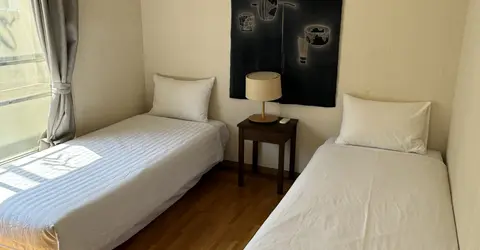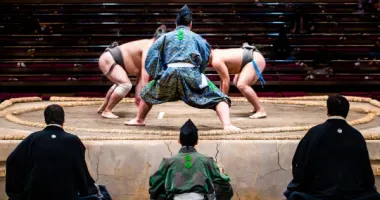Musashi Imperial Graveyard Hachioji Tokyo
The Musashi Imperial Graveyard in Hachioji, Tokyo holds the graves of the emperors Taisho and Showa and their wives. It is a solemn and dignified place.
Musashi Imperial Graveyard, Hachioji, Tokyo 武蔵陵墓地 八王子市 東京
- Imperial Burial Rites
- Buddhist Funerals
- Shinto Funerals
- Emperor Meiji
- Emperor Taisho
- Emperor Showa
- Emperor Heisei
- Access
by Johannes Schonherr
 Grave of Emperor Showa (died in 1989) at the Musashi Imperial Graveyard, Hachioji, Tokyo
Grave of Emperor Showa (died in 1989) at the Musashi Imperial Graveyard, Hachioji, Tokyo Cedar trees at the Musashi Imperial Graveyard, Hachioji, Tokyo
Cedar trees at the Musashi Imperial Graveyard, Hachioji, Tokyo
The Musashi Imperial Graveyard near Takao Station in Hachioji city just outside urban Tokyo contains the burial mounds of Emperor Taisho and Emperor Showa. Also buried here are their widows, Empress Teimei and Empress Kojun, respectively.
From Koshu Kaido Road, an impressive Zelkova tree lined avenue (Keyaki Namiki Dori) leads to the graveyard.
The graveyard itself is essentially a large semi-natural cedar tree forest with wide gravel roads connecting to the burial sites.
Each burial site is fronted by a torii gate, marking the site as a holy Shinto shrine. Behind the torii, stone steps lead up to the burial mounds in which the emperors and their widows are interred.
Visitors can however go only as far as to the bottom of the steps. Low gates block further access but allow for a good view of the burial mounds.
The graves of Emperor Taisho and the grave of his widow, Empress Teimei, are called the Tama-no-misasagi graves. The graves of Emperor Showa and the grave of his widow, Empress Kojun, are named the Musashi-no-misasagi graves.
All markings inside the graveyard park are in Japanese. A display at the entrance however gives directions to all graves in English, along with further information.
The information includes the advice that there is no rest room inside the graveyard. Please use the one next to the parking lot. Toilet facilities inside an imperial graveyard - that would be unthinkable. Emperors used to be near deities after all.
It is also prohibited to eat, drink and smoke inside the graveyard, no pets are allowed except for service dogs helping people with physical challenges.
Those restrictions, aimed at maintaining the solemnity of the place, succeed in keeping noisy leisure crowds away. Police officers stationed in front of each set of graves make sure that the rules are observed.
Thus, the graveyard is very serene and very quiet. The few visitors are mostly elderly Japanese. Many of them take their hats or caps off before walking through the torii in front of the graves, they deeply bow and sometimes pray in front of the graves.
Sitting on one of the few large stone slabs serving as benches near the graves and looking at the burial mounds, watching the occasional visitor approaching in deep respect, is a mesmerizing experience. Those graves do exude a sort of mystic energy. You can almost physically feel it.
The graves were designed to do exactly that.
 Man praying in front of the grave of Emperor Taisho (died in 1926), Hachioji, Tokyo
Man praying in front of the grave of Emperor Taisho (died in 1926), Hachioji, Tokyo
A Short History of Japanese Imperial Burial Rites
To understand the concept of the current imperial graves, we have to go back 1,500 years, back to pre-Buddhist Japan in the 5th and 6th century.
At that time, large burial mounds (kofun) were erected once an emperor died. The burial gifts interred in the mounds alongside the imperial body were enormous and often overpowered the general economy.
The metal production of years was sunk into the graves in the form of multiple swords and armaments, jewelry and other gifts supposed to help to ease the journey to heaven for the deceased. The mourning periods lasted for as long as a year and were typically years of unrest and attempted coup d'états.
 Historical Buddhist imperial grave at Sennyuji Temple in Kyoto (photo: Mainichi Shimbun)
Historical Buddhist imperial grave at Sennyuji Temple in Kyoto (photo: Mainichi Shimbun) Historical Buddhist imperial graves to the left, the grave of Emperor Komei (died in 1867) to the right, Sennyuji Temple, Kyoto (photo: Mainichi Shimbun)
Historical Buddhist imperial graves to the left, the grave of Emperor Komei (died in 1867) to the right, Sennyuji Temple, Kyoto (photo: Mainichi Shimbun)
Buddhist Funerals
With the onset of the Nara Period (710 - 794), those excesses were decidedly scaled back. Buddhism became the religion of the emperors, newly adopted Chinese customs demanded modesty.
Thus, the emperors soon chose to be cremated, their ashes kept at graves marked with small stone pagodas at Buddhist temples.
Many emperors abdicated and withdrew into monasteries, living out their final days as humble monks. Thus, no large-scale funerals were held for them.
From the funeral of Emperor Go-Horikawa in 1234 on, Sennyuji Temple near Kyoto became the main Imperial Burial Ground. Almost all emperors succeeding Go-Horikawa were laid to rest at the temple up to the end of the Edo Era in 1868.
A shift took place with the burial of Emperor Go-Komyo in 1654. He was the first emperor not to be cremated since Nara times. Though his funeral and those of his successors were still strictly Buddhist, the deceased emperors became from then on interred again - their body left intact when set to rest.
This led to sometimes violent reactions by Buddhist monks insisting on cremation, including attempted kidnapping of corpses, but the idea of internment for imperial bodies prevailed.
Shinto Funerals
The opening of Japan towards the outside world at the end of the Edo Period shifted the power balance between Buddhists and the followers of Shinto.
At the time, Shinto was promoted as the real Japanese religion while Buddhism was looked down upon as an import from China, by then a weak and impoverished country, partly colonized by western powers.
Emperor Komei (1831 - 1867), the emperor reigning during the chaotic final days of the Edo Period, was the first to receive a newly fashioned Shinto funeral.
Though he was still interred on the grounds of Sennyuji Temple, his grave is very different from the ones of his ancestors at the site: he was interred in a burial mound modeled on the ancient pre-Nara Period traditions.
For many centuries, Buddhism had defined the funeral rites for almost all Japanese. There were no immediate Shinto rites the Imperial Household Agency could draw from.
Thus, with the help of archeologists and scholars of the ancient Japanese books, such as the Manyoshu and the Kojiki, new rites more or less vaguely based on the pre-Buddhist Shinto traditions needed to be developed.
While the funeral of Emperor Komei was just a national affair in times of general turmoil, the funeral of Emperor Meiji, the son of Emperor Komei, took place in an entirely different political climate.
 Grave of Emperor Meiji (died in 1912), Fushimi Momoyama, Kyoto
Grave of Emperor Meiji (died in 1912), Fushimi Momoyama, Kyoto
Emperor Meiji
By 1912, the year of the funeral of Emperor Meiji, Japan had become an international powerhouse. Japan had defeated both China and Russia in recent wars, and the country wanted to be on equal standing with the western powers.
Thus, the funeral became a huge international event with many foreign dignitaries attending. Shinto had become the religious force combining the notion of Japan as an untouchable independent territory holding on to its very own traditions with the idea of thorough modernization to maintain exactly that status in face of the imperialist western powers.
The funeral rites for the Meiji Emperor were held in Tokyo, where he had resided, but he was interred in Kyoto, his birthplace. Not at Sennyuji Temple but at his very own grave site in Fushimi Momoyama in southern Kyoto.
 Keyaki Namiki Dori (Zelkova Avenue) leading to the Musashi Imperial Graveyard, Hachioji, Tokyo
Keyaki Namiki Dori (Zelkova Avenue) leading to the Musashi Imperial Graveyard, Hachioji, Tokyo
Emperor Taisho
Emperor Taisho took over the reign from Emperor Meiji. He died in early 1926 and was the first to be interred at the new Musashi Imperial Graveyard in Hachioji.
After a large Shinto ceremony at a makeshift funeral place in Shinjuku Gyoen Park, his remains were taken to Takao Station, Hachioji by train.
As customary for imperial funerals, his final interment celebrations took place at night. Or rather, in the early morning, from 5 am to 6 am at the end of a long winter night, in minus 10 degrees Celsius.
 Grave of Empress Kojun, the widow of Emperor Showa (died in 2000), Hachioji, Tokyo
Grave of Empress Kojun, the widow of Emperor Showa (died in 2000), Hachioji, Tokyo
Emperor Showa
His son, Emperor Showa, served as the national spiritual force during the aggravated modernization of the 1930's as well as during the war with China at the end of the decade, eventually resulting in World War II.
After Japan's surrender in 1945, his role was cut down by the American occupational forces from Shinto divinity to a purely representational figure.
In this capacity, he oversaw the post-war rise of Japan including the 1964 Tokyo Olympics which symbolized the return of Japan to the league of first-world developed countries.
As well, the Showa Period witnessed the bubble economy at the end of the 1980's when Japan briefly became a serious competitor to the U.S. economy at large.
At the time of the death of Emperor Showa in 1989, Japan was perhaps at its strongest point ever.
Accordingly, the funeral of Emperor Showa was one of the largest funeral celebrations ever held. Representatives from 163 countries attended, including 55 heads of state.
They included American president George Bush senior, French president François Mitterrand but also traditional nobility like the kings of Sweden and Belgium. Prince Philip, the Duke of Edinburgh, attended as the representative of Britain.
Plenty of by now long disposed dictators were also present, for example, Mobuto Sese Soko of Zaire (by now the Democratic Republic of Congo).
Since Emperor Showa was stripped of his divinity, much thought went into the ceremonies.
The Imperial Household Agency came up with a compromise: a traditional Shinto ceremony held at a makeshift funeral palace in Shinjuku Gyoen Park, followed immediately by a secular state funeral in western style at the same location but with all Shinto markings removed.
Then a large motorcade took the imperial body to the Musashi burial grounds were he was interred in daytime - another first. Before, emperors were always buried at night.
 Keyaki Namiki Dori with the funeral procession for Emperor Showa passing through (1989), Hachioji, Tokyo (photo: Mainichi Shimbun)
Keyaki Namiki Dori with the funeral procession for Emperor Showa passing through (1989), Hachioji, Tokyo (photo: Mainichi Shimbun)
Emperor Heisei
According to press reports, retired Heisei Era (1989-2019) Emperor Akihito and his wife Michiko plan to get cremated, breaking again the line of tradition. They will also be buried at the Musashi Imperial Graveyard in Hachioji when their time comes.
Musashi Imperial Graveyard Access
Access is from Takao Station on the JR Chuo Line and the Keio Takao Line. Leave Takao Station through its North Exit.
For a walk along the impressive Zelkova Avenue, turn right at Koshu Kaido Avenue close to the station exit. Walk to the junction marked as Tamagoryo Entrance, there turn left. The walk from Takao Station to the Musashi Imperial Graveyard takes about 20 minutes (about 2 km).
The graveyard website below indicates a shorter walk.
Opening times: daily from 9 am to 4 pm, entry up to 3.30 pm
Admission is free.
Tel. 042 661 0023
Address: Tokyo, Hachioji city, Nagabusa-machi 1833
Website in Japanese: www.kunaicho.go.jp/ryobo/guide/124/ with detailed walking map www.kunaicho.go.jp/ryobo/guide/124/pdf/map1.pdf (in Japanese but featuring photos)






























